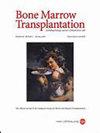Intermediate-dose TBI/fludarabine conditioning for allogeneic hematopoietic cell transplantation in patients with peripheral T-cell lymphoma
IF 4.5
2区 医学
Q1 HEMATOLOGY
引用次数: 0
Abstract
Allogeneic hematopoietic cell transplantation (alloHCT) is an effective treatment for patients with relapsed/refractory peripheral T-cell lymphoma (PTCL), but the contribution of the conditioning regimen is still unclear. Here we present a retrospective single-center study using conditioning with intermediate-dose total body irradiation (TBI) and fludarabine for alloHCT in PTCL. Forty-seven patients underwent alloHCT for PTCL between 2010 and 2023 after conditioning with fludarabine and intermediate-dose TBI (8 Gy in 87% of the cases). In most patients alloHCT was administered as part of second-line therapy, in 22 (47%) patients after having been primary refractory, and 21 (45%) of the patients were chemoresistant at alloHCT. With a median follow-up of 5.5 years, 5-year progression-free survival (PFS), overall survival, relapse incidence, and non-relapse mortality were 61%, 65%, 24%, and 15%, respectively. The 5-year PFS of patients transplanted with stable disease and progressive disease was 57% and 26%, respectively. Of 11 relapses, only 2 (18%) occurred beyond 6 months post transplant, and no relapse was observed after onset of chronic graft-versus-host disease. AlloHCT with intermediate-dose TBI/fludarabine conditioning is associated with a favorable toxicity/efficacy profile and can provide durable survival in a substantial fraction of patients with PTCL including those with poorly controlled disease at transplant.

中剂量TBI/氟达拉滨调节外周t细胞淋巴瘤患者异体造血细胞移植。
同种异体造血细胞移植(Allogeneic hematopoietic cell transplantation, alloHCT)是一种治疗复发/难治性外周t细胞淋巴瘤(PTCL)的有效方法,但调理方案的作用尚不清楚。在这里,我们提出了一项回顾性的单中心研究,使用中剂量全身照射(TBI)和氟达拉滨治疗PTCL的同种异体hct。2010年至2023年间,47例患者在接受氟达拉滨和中剂量TBI治疗(87%的病例接受8gy)后接受了同种异体hct治疗PTCL。在大多数患者中,同种异体hct作为二线治疗的一部分,22例(47%)患者在原发性难治性治疗后,21例(45%)患者在同种异体hct上出现化疗耐药。中位随访时间为5.5年,5年无进展生存率(PFS)、总生存率、复发率和非复发死亡率分别为61%、65%、24%和15%。病情稳定和进展的移植患者的5年PFS分别为57%和26%。在11例复发中,只有2例(18%)发生在移植后6个月以上,并且在慢性移植物抗宿主病发作后未观察到复发。同种异体hct与中剂量TBI/氟达拉滨调节相关,具有良好的毒性/疗效,可以为相当一部分PTCL患者提供持久的生存,包括移植时疾病控制不佳的患者。
本文章由计算机程序翻译,如有差异,请以英文原文为准。
求助全文
约1分钟内获得全文
求助全文
来源期刊

Bone Marrow Transplantation
医学-免疫学
CiteScore
8.40
自引率
8.30%
发文量
337
审稿时长
6 months
期刊介绍:
Bone Marrow Transplantation publishes high quality, peer reviewed original research that addresses all aspects of basic biology and clinical use of haemopoietic stem cell transplantation.
The broad scope of the journal thus encompasses topics such as stem cell biology, e.g., kinetics and cytokine control, transplantation immunology e.g., HLA and matching techniques, translational research, and clinical results of specific transplant protocols. Bone Marrow Transplantation publishes 24 issues a year.
 求助内容:
求助内容: 应助结果提醒方式:
应助结果提醒方式:


